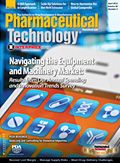Representative Sampling
Understanding the differences between convenience, target, and self-selected samples.
Representative samples and sampling are addressed multiple times in the cGMPs. For example, in Part 21 of the Code of Federal Regulations, section 211.84(b), it states: "Representative samples of each shipment of each lot shall be collected for testing or examination."Section 211.134(b) states, "A representative sample of units shall be collected at the completion of finishing operations and shall be visually examined for correct labeling;" Section 211.160(b)(1, 2, 3) states, "Samples shall be representative and identified;" and Section 211.110.(a) states, " … examinations to be conducted on appropriate samples of in-process materials of each batch."

Lynn D. Torbeck
A definition is also given in the regulations under Section 210.3(b)(21): "Representative sample means a sample that consists of a number of units that are drawn based on rational criteria such as random sampling and intended to assure that the sample accurately portrays the material being sampled."
Ideally, as the above definition suggests, the industry should always take a true random sample where every item or unit has an equal opportunity or probability of being selected. A random number source should be used to select the units.
True random samples are often difficult or impossible to obtain. We cannot, for example, label each vial in a lot of 2000 vials and sample those that have random numbers based on a random number generator. Note that the cGMPs do not require a true random sample, but do require a representative sample based on a rational criterion.
In a representative sample, every unit may not have an equal opportunity, but it is reasonable to believe that samples can be taken to truly reflect the characteristics of the lot being sampled. As an aside, note that the only way to judge if a sample is truly representative is to actually observe the physical sample being taken.
Once a sample has been selected, it is not possible to know whether it was taken correctly. Thus, the importance of a well written SOP and a culture of always following the SOP exactly as written.
The key to sampling is the rational criteria. There must be some documented basis for the way the sample is taken. If well executed and documented, the types of sampling that follow should meet this requirement.
The most common sampling approach used in the bio/pharmaceutical industry to approximate a representative sample is to take three samples, one at the beginning of a production run, one at the middle, and one at the end of the run.
The assumption is that the process is uniform throughout the run and there are no special causes acting within the run. Prior knowledge is expected to justify this approach. Data from the validation runs or historical data can be used.
As the names imply, judgment, convenience or grab samples are samples that are taken as convenience, opportunity, or expertise permits. At worst, it is a convenience sample that is not representative of the lot. At best, it can be a truly representative sample based on the historical experience and expert knowledge.
A convenience sample is often taken at the end of a continuous production line. The operator simply selects samples as they go by without rational criteria. On a glass manufacturing line, the last operator selects ampoules for the pre-shipment or tail-gate sample for the customer's incoming quality inspection. Without documented criteria these samples are inherently suspect.
At a customer's facility, the empty glass vials are often sampled from a shrinkwrapped pallet by taking vials from the corners of the pallet at each layer but alternating the corners for each layer. Although not random, this process is convenient because the pallet need not be disassembled to the sample. If the vendor does not put bad products in the center of the pallet, this approach is representative.
A target sample is taken from a specific location that is usually specified in the batch record, SOP, or protocol. For example, it would be appropriate to sample the wash water from the drain at the bottom of the tank after cleaning or to sample at the known worst-case location in a mixer.
In systematic sampling, units are taken at fixed intervals or on a periodic basis. For example, taking 10 filled vials every half hour or every 1000 units. As long as one knows from prior evidence that there are no periodic changes in the characteristic being measured, such as fill volume, then this approach is considered representative.
As the name implies, self-selected samples are volunteer samples. For example, people that are willing to participate in a survey would be considered self-selected samples. These people would not be considered to be a random sample or to be representative of the group under consideration. In many ways, this type of sample is worst than no sample. Because the sample is not representative, any conclusions drawn can be incorrect and misleading at best, and at worst, dangerous. Self-selected samples should not be used for a GMP-related study.
For example, an organization sent out a questionnaire to 85 companies to find out the AQL values that companies use for attribute sampling plans. Only five companies replied. These responses are not representative of the other 80 companies since only those that wanted to respond actually responded.
In another example, if we were to ask employees to voluntarily discuss how and when they have violated GMPs as a way to assess a new CGMP training course, we would in all likelihood, not get an accurate measure of the number of violations.
At the end of the day, representative samples and sampling are a regulatory requirement and must be scientifically defensible.
Lynn D. Torbeck is a statistician at PharmStat Consulting, 2000 Dempster, Evanston, IL 60202, tel. 847.424.1314, LDTorbeck@PharmStat.com, www.PharmStat.com.
